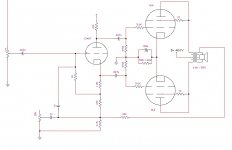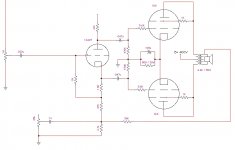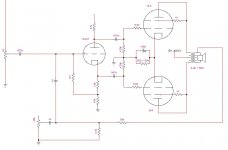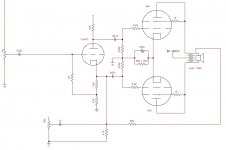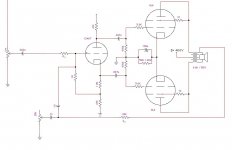I am trying to design an output stage with a minimal tube count. I have settled on the concertina splitter since it uses only one tube to so it's dirty work.
My problem is: I am having trouble visualizing I can inject NFB? Preceeding the splitter is a tone network that is fed from a cathode follower, and then a volume control, so I don't want to inject it into that stage since it will alter the foreward gain in the loop as the tone and volume controls are altered.
So I assume that I have to inject it into the concertina itself. I have drawn up a few variations. The .1uF capacitor I suppose is the culprirt in question.
My problem is: I am having trouble visualizing I can inject NFB? Preceeding the splitter is a tone network that is fed from a cathode follower, and then a volume control, so I don't want to inject it into that stage since it will alter the foreward gain in the loop as the tone and volume controls are altered.
So I assume that I have to inject it into the concertina itself. I have drawn up a few variations. The .1uF capacitor I suppose is the culprirt in question.
Attachments
Be much easier to just use a LTP. The LTP has both inverting and non-inverting inputs, so there's a natural summing node for NFB. Since types like the 12A*7 series, the 6BQ7, etc. are all dual tridoes, the tube count doesn't change.
FWIW: avoid the 12AU7A. That one has horrible linearity and more distortion than you want.
FWIW: avoid the 12AU7A. That one has horrible linearity and more distortion than you want.
Unfortunately, I am using the other half of the 12au7 for the preceeding stage cathode follower, that's why I went with concertina instead of LTP. I thought about subbing in a 12ax7 or 12at7 for the 12au7, but I'll deal with that later. It is the NFB that has me stumped.
Thanx
Thanx
Negative feedback works by trading off gain for distortion/bandwidth/impedance. The problem is that your circuit has no gain to start with...
It's difficult-to-impossible to feedback to a split-load; generally, the split-load is driven by a gain stage and the feedback is brought back to that stage.
It's difficult-to-impossible to feedback to a split-load; generally, the split-load is driven by a gain stage and the feedback is brought back to that stage.
If you have to go with the cathodyne, then your best bet would probably be something like what I attached. With the cathodyne, you really don't have a second input for the NFB summing node. So try something like the inverting connection that you'd use with an op-amp. In this case: Avcl= Rf/Rs (or close to it).
Attachments
SY said:BTW, when you revise the circuit, make sure that the lower output is taken from the top of the load resistor, not from the load plus cathode resistor.
I have seen them noth ways, with the signal coming off the junction of the loadresistor/cathode resistor, and with the signal coming off the junctuin of the cathode trsistor/cathode.
Is there a benefit in doing it the other way? Possibly an impedance issue that I am missing?
Miles Prower said:If you have to go with the cathodyne, then your best bet would probably be something like what I attached. With the cathodyne, you really don't have a second input for the NFB summing node. So try something like the inverting connection that you'd use with an op-amp. In this case: Avcl= Rf/Rs (or close to it).
Sweet, thanx for that one.
I am seeing the issue now with the lack of gain in the cathodyne. Maybe I'll rethink the output stage... possibly using a self-split conficuration for the output tubes and using that half of a dual triode as a gain stage /driver and return the NFB there.
Balance. Think of the current flow. There's no path other than straight down from the B+ to ground (the grid draws no current). So any ac current is multiplied by the resistance to ac ground (which is the B+ rail and ground). The cathode bias resistor adds an error to the bottom drive voltage.
So since you need symmetry to achieve balance, you can either take the lower signal from the top pf the load resistor or you can take it from the cathode and bypass the bias resistor with a big ol' electrolytic cap.
BTW, a conventional common-cathode voltage amplifier direct coupled to the split-load inverter is boring and common. And it's boring and common for a reason- it works really, really well.
So since you need symmetry to achieve balance, you can either take the lower signal from the top pf the load resistor or you can take it from the cathode and bypass the bias resistor with a big ol' electrolytic cap.
BTW, a conventional common-cathode voltage amplifier direct coupled to the split-load inverter is boring and common. And it's boring and common for a reason- it works really, really well.
I am trying to design an output stage with a minimal tube count. I have settled on the concertina splitter since it uses only one tube to so it's dirty work.
Giving this some further thought, it looks like this is going to be conected to a fairly high-level preamp. In this case, why not just do away with the cathodyne altogether and use the 6L6's as a differential power amp? That way, it does its own phase splitting. Adding a CCS in the tail will improve balance greatly, and you won't be needing any feedback on this.
Just a thought.
SY said:Balance. Think of the current flow. There's no path other than straight down from the B+ to ground (the grid draws no current). So any ac current is multiplied by the resistance to ac ground (which is the B+ rail and ground). The cathode bias resistor adds an error to the bottom drive voltage.
Well, I have mostly seen it in old guitar amps, and early PA systems... probably just bad design then.
BTW, a conventional common-cathode voltage amplifier direct coupled to the split-load inverter is boring and common. And it's boring and common for a reason- it works really, really well.
[/QUOTE]
HAHA! Yeah, true enough.
The concertina has one hi-Z input and two odd-Z outputs. The obvious way to take feedback, as Miles says, is like you wire an op-amp as an inverting amp.
The 6L6 will need about 25V peak at the grid, give about 12RMS or 18V peak at an 8Ω load. The concertina has gain just under unity. So the overall amp, before feedback, has 27Vpk in, 18Vpk out, gain is 0.66. Passive feedback factor is 1:1 for non-inverting mode, 2:1 for inverting mode. As SY says: you got no gain and can't really get any feedback at all.
The transformer can be wound to (not necessarily bought) any ratio and output impedance. If the output is 600Ω, 27Vpk in gives maybe 140Vpk output. If you could rig a concertina for non-inverting unity gain, you could get 14dB NFB; since you must rig it inverting, only 8dB NFB. Of course 600Ω is an uncommon speaker impedance. We could wind both an 8Ω for the speaker and a 600Ω winding for the feedback; the two windings won't couple exactly the same thing, and the copper resistance of the 8Ω winding will not be reduced by feedback. Note that unity-gain implies that the input signal at the pot wiper must be like 150Vpk. If we want just 6dB of reserve gain in hand, the preceding stage must produce 300Vpk. I'd prefer to see 10dB or 20dB reserve gain, 450Vpk-900Vpk. That's insane.
Power amps that take a "comfortable" input level (a volt or so) and drive "wires" (voice coils, lines, line transformers) almost invariably need a Power tube and a Volt-amp tube. The concertina is not a volt-amp. You need another tube in there. Either one between volume pot and concertina, or two between concertina and 6L6s. The first way is simpler and also gives a reasonably good place to inject feedback. It is of course THE most common way to wire a push-pull power amp.
The LTP is also an option. If you want a lot of gain or NFB, and have a low final output impedance, note that a LTP gives half (or less) the gain of the same two tubes as volt-amp/concertina. 12AU7 amp/concer gives gain of 16 to each 6L6 grid; 12AU7 LTP gives gain of 8 to each 6L6 grid. The LTP does have an infinite-Z feedback input while the volt-amp's feedback node is under 1K. For hi-fi line-amps with limited output current, the load of that feedback input limits performance. For 8Ω outputs which could easily carry a 100Ω feedback network, the low Z of the volt-amp cathode is no big deal.
The LTP is forced to use similar devices, which must give high gain without high plate resistance. You typically get modest gain and impedance. The concertina has similar output impedance (the bottom output is not so low-Z as it looks) but high input resistance, which means the volt-amp can be worked at higher gain than it could driving a 6L6 grid, and can even be a different device of much higher gain. 12AX7 driving 12AU7 was a popular rig. 7199 is a pentode+triode and can give gain over 200 to each 6L6 grid.
LTP has a natural symmetry and beauty. I used it a lot in my youth, works good. Fender uses a bodged LTP in all their big amps, and they do fine. Yet Ampeg did fine with voltamp+concertina, and I'm favoring that plan now. The "push-pull" of the LTP isn't perfect, especially at high levels. The concertina has so much internal feedback that it can be insanely linear up to higher levels than any pair of plates.
BTW: what is this pot-cap hanging on your feedback loops? Is this a gitar amp? It may help to know what the amp is supposed to be: a hi-fi amp and a gitar amp suggest very different choices.
Oh: in Mile's suggested plan, the "obvious" place for the pot-cap stuff is across Rs, not grid to ground. But coming off a pot wiper, it may not have much effect. Taken to ground, it won't affect gain much, it will reduce NFB at high frequencies (which may have use in screamin-gitar work).
Does this go with your super-gain cascode? I was thinking about that. The only reason to have that much gain is for huge (impractical) feedback, or..... to build a 2-stage guitar amp. Gain of 1,000 into a 6L6 gives input sensitivity of 25mV, a usable gitar sensitivity. Traditionally we run 2 or 3 12AX7 or 12AT7 stages to do the same thing. Reducing the number of stages will change the flavor, though maybe not a whole lot. Fewer stages gives fewer opportunities to insert EQ and gain-structure controls, which are essential to some guitar work. Feel free to explore, but have a look at where you are going.
Oh... you do realize that triode-strapped push-pull 6L6 will work very fine without any NFB at all? Maybe too clean for guitar. Not dead-clean for hi-fi, but less NFB-induced garbage than many plans.
The 6L6 will need about 25V peak at the grid, give about 12RMS or 18V peak at an 8Ω load. The concertina has gain just under unity. So the overall amp, before feedback, has 27Vpk in, 18Vpk out, gain is 0.66. Passive feedback factor is 1:1 for non-inverting mode, 2:1 for inverting mode. As SY says: you got no gain and can't really get any feedback at all.
The transformer can be wound to (not necessarily bought) any ratio and output impedance. If the output is 600Ω, 27Vpk in gives maybe 140Vpk output. If you could rig a concertina for non-inverting unity gain, you could get 14dB NFB; since you must rig it inverting, only 8dB NFB. Of course 600Ω is an uncommon speaker impedance. We could wind both an 8Ω for the speaker and a 600Ω winding for the feedback; the two windings won't couple exactly the same thing, and the copper resistance of the 8Ω winding will not be reduced by feedback. Note that unity-gain implies that the input signal at the pot wiper must be like 150Vpk. If we want just 6dB of reserve gain in hand, the preceding stage must produce 300Vpk. I'd prefer to see 10dB or 20dB reserve gain, 450Vpk-900Vpk. That's insane.
Power amps that take a "comfortable" input level (a volt or so) and drive "wires" (voice coils, lines, line transformers) almost invariably need a Power tube and a Volt-amp tube. The concertina is not a volt-amp. You need another tube in there. Either one between volume pot and concertina, or two between concertina and 6L6s. The first way is simpler and also gives a reasonably good place to inject feedback. It is of course THE most common way to wire a push-pull power amp.
The LTP is also an option. If you want a lot of gain or NFB, and have a low final output impedance, note that a LTP gives half (or less) the gain of the same two tubes as volt-amp/concertina. 12AU7 amp/concer gives gain of 16 to each 6L6 grid; 12AU7 LTP gives gain of 8 to each 6L6 grid. The LTP does have an infinite-Z feedback input while the volt-amp's feedback node is under 1K. For hi-fi line-amps with limited output current, the load of that feedback input limits performance. For 8Ω outputs which could easily carry a 100Ω feedback network, the low Z of the volt-amp cathode is no big deal.
The LTP is forced to use similar devices, which must give high gain without high plate resistance. You typically get modest gain and impedance. The concertina has similar output impedance (the bottom output is not so low-Z as it looks) but high input resistance, which means the volt-amp can be worked at higher gain than it could driving a 6L6 grid, and can even be a different device of much higher gain. 12AX7 driving 12AU7 was a popular rig. 7199 is a pentode+triode and can give gain over 200 to each 6L6 grid.
LTP has a natural symmetry and beauty. I used it a lot in my youth, works good. Fender uses a bodged LTP in all their big amps, and they do fine. Yet Ampeg did fine with voltamp+concertina, and I'm favoring that plan now. The "push-pull" of the LTP isn't perfect, especially at high levels. The concertina has so much internal feedback that it can be insanely linear up to higher levels than any pair of plates.
BTW: what is this pot-cap hanging on your feedback loops? Is this a gitar amp? It may help to know what the amp is supposed to be: a hi-fi amp and a gitar amp suggest very different choices.
Oh: in Mile's suggested plan, the "obvious" place for the pot-cap stuff is across Rs, not grid to ground. But coming off a pot wiper, it may not have much effect. Taken to ground, it won't affect gain much, it will reduce NFB at high frequencies (which may have use in screamin-gitar work).
Does this go with your super-gain cascode? I was thinking about that. The only reason to have that much gain is for huge (impractical) feedback, or..... to build a 2-stage guitar amp. Gain of 1,000 into a 6L6 gives input sensitivity of 25mV, a usable gitar sensitivity. Traditionally we run 2 or 3 12AX7 or 12AT7 stages to do the same thing. Reducing the number of stages will change the flavor, though maybe not a whole lot. Fewer stages gives fewer opportunities to insert EQ and gain-structure controls, which are essential to some guitar work. Feel free to explore, but have a look at where you are going.
Oh... you do realize that triode-strapped push-pull 6L6 will work very fine without any NFB at all? Maybe too clean for guitar. Not dead-clean for hi-fi, but less NFB-induced garbage than many plans.
OOOh, yes, it is for a geetar amp. The NFB also allows for the attenuation of NFB at high frequencies...eg a presence control, that's the hanging capacitor stuff. it is being fed from a very high gain preamp...4 cascaded 12ax7 sections into a cathode follower and then a tone stack. The preamp design is not original, but tried and true with some tweaks so that it will make more sense gainwise. The preamp is pretty much set in stone... the values are carefully balanced to clip in just the right way...the cathode follower too! So I can't run any feedback there.
I'm helping a bud out with a few things by distilling a circuit down to it's simplest possible form. I personally like to go more over the top with my own stuff, but he has never even built an amp before, so naturally I thought that the concertina would be the simplest wat from point A to point B in a Class AB1 output stage. I thought if I deleted the typical grounded cathode driver that normally preceeds the concertina, and ran the signal right from the master volume, that I could avoid having to add another dual triode just to use half of it. But then I coildn't figure out where to run the dar-ned global NFB!
I have run NFB into the top grid of a LTP inverter before, with great results, so I thought I'd just do that here, but I started tnkering and had to call on the experts.
It's not going with my crazy cascode of DOOM, that is just a learning experience for me to expand my knowledge of how best to blowing audio amps up ;-)
I'm helping a bud out with a few things by distilling a circuit down to it's simplest possible form. I personally like to go more over the top with my own stuff, but he has never even built an amp before, so naturally I thought that the concertina would be the simplest wat from point A to point B in a Class AB1 output stage. I thought if I deleted the typical grounded cathode driver that normally preceeds the concertina, and ran the signal right from the master volume, that I could avoid having to add another dual triode just to use half of it. But then I coildn't figure out where to run the dar-ned global NFB!
I have run NFB into the top grid of a LTP inverter before, with great results, so I thought I'd just do that here, but I started tnkering and had to call on the experts.
It's not going with my crazy cascode of DOOM, that is just a learning experience for me to expand my knowledge of how best to blowing audio amps up ;-)
This guy is SLICK! That is the plan exactly. Which is why I don't give a darn about bandwidth and noise (well...a little bit about noise) Plus I'll be slugging the input wth 2 volts from the pickups, so that gives some room too.PRR said:The only reason to have that much gain is for huge (impractical) feedback, or..... to build a 2-stage guitar amp. Gain of 1,000 into a 6L6 gives input sensitivity of 25mV, a usable gitar sensitivity.
OK you need half of a 12AU7. I forgot about this when you asked about 7 pin tubes. 1/2 of 12AU7 = 6C4. Need half of a 12AX7 use 6AV6. I know that musicians like tubes that can be bought at SAM ASH, so you are stuck with 12A*7. I am sure that you can find use for the other half. Vibrato, NAH too out of style. Reverb driver, maybe. Effects loop driver?
I am sure that you have heard of the 12DW7, invented for Ampeg, it is 1/2 of 12AX7 and 1/2 of 12AU7 in the same envelope. The Russians (and maybe the Chinese) are making new ones.
I am sure that you have heard of the 12DW7, invented for Ampeg, it is 1/2 of 12AX7 and 1/2 of 12AU7 in the same envelope. The Russians (and maybe the Chinese) are making new ones.
tubelab.com said:
I am sure that you have heard of the 12DW7, invented for Ampeg, it is 1/2 of 12AX7 and 1/2 of 12AU7 in the same envelope. The Russians (and maybe the Chinese) are making new ones.
Cool. I didn't know that they were back in production. Have you heard them yet? I'd be intereted to see how they turned out.
Now if only someone would remake a nice mercury rectifier, like an 83...
- Status
- This old topic is closed. If you want to reopen this topic, contact a moderator using the "Report Post" button.
- Home
- Amplifiers
- Tubes / Valves
- A question about Cathodyne/split load/concertina PI's
